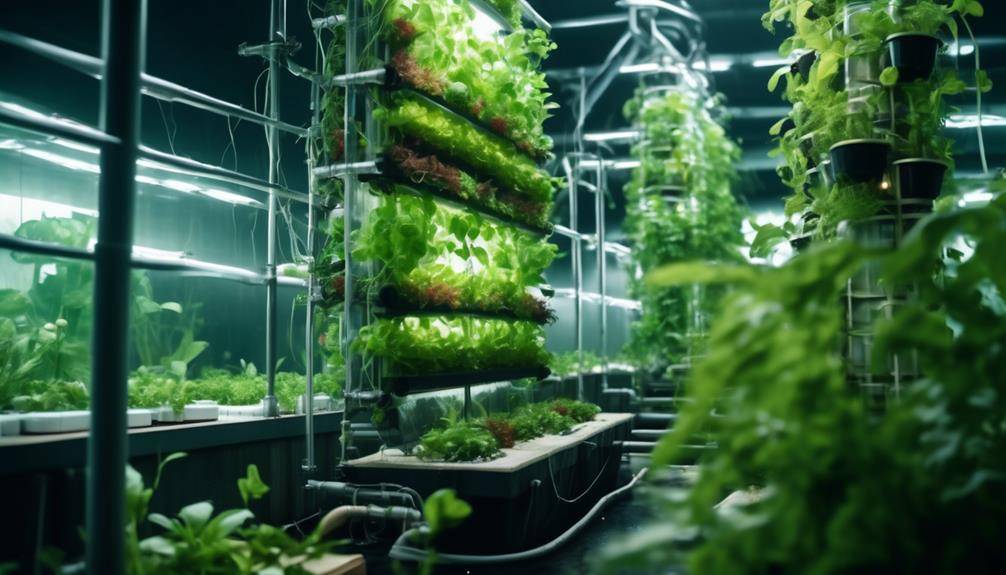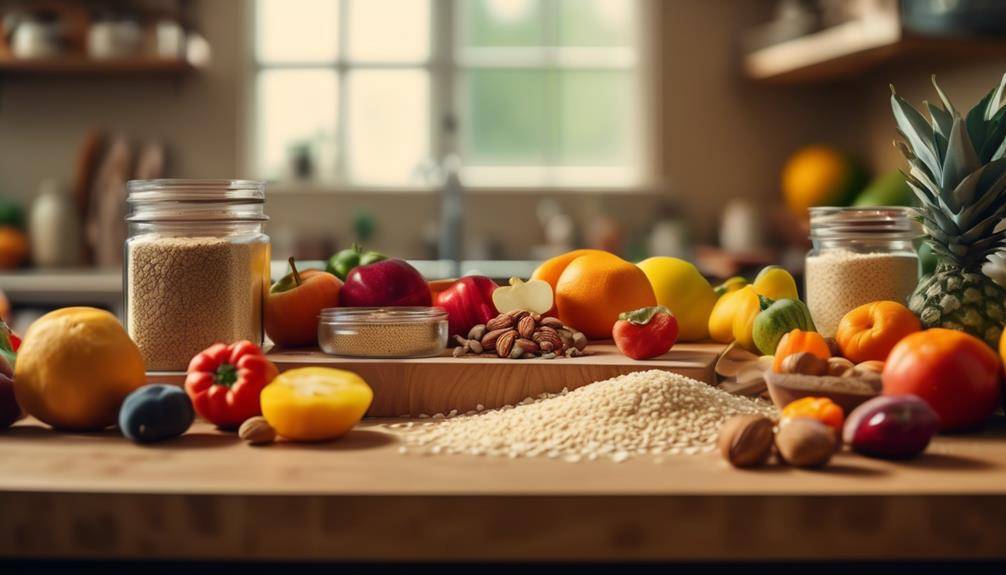The Best Efficient Use Of Space In Aquaponics

Use Of Space In Aquaponics; In the world of aquaponics, space is a precious commodity, much like sunlight filtering through the leaves of a thriving garden. It’s a delicate dance of balancing the needs of fish and plants, all within a limited area. But fear not, for there are ways to efficiently utilize every inch of your aquaponics setup. From vertical growing systems that make the most of unused airspace, to compact fish tanks that optimize space usage, there are innovative design ideas and techniques that can revolutionize your aquaponics experience. So, prepare to uncover the secrets of maximizing efficiency in aquaponics, and discover how you can create a flourishing ecosystem within the confines of your own space.
Vertical Growing Systems
Vertical growing systems are an efficient method for maximizing space utilization and increasing crop yields in aquaponics. By utilizing vertical space, aquaponic farmers can optimize their production and make the most of limited resources. Vertical farming techniques offer a practical solution for overcoming space constraints and providing a sustainable approach to food production.
One of the key advantages of vertical growing systems is their ability to maximize space utilization. By stacking plants vertically, farmers can grow more crops in a smaller footprint, thus increasing overall productivity. This is particularly useful in urban environments where land is limited. Vertical farming techniques allow for the cultivation of a wide variety of crops, including leafy greens, herbs, and even certain fruits and vegetables.
In addition to space efficiency, vertical growing systems also offer benefits in terms of crop yields. With plants stacked vertically, each plant receives ample sunlight, nutrients, and water, leading to healthier and more vigorous growth. The controlled environment of aquaponics ensures optimal conditions for plant growth, further enhancing crop yields. This makes vertical growing systems a viable option for commercial aquaponic operations looking to maximize profitability.
Furthermore, utilizing vertical space in aquaponics promotes sustainability and resource efficiency. By growing plants vertically, farmers can reduce the need for extensive land use and limit soil erosion. Vertical farming techniques also require less water compared to traditional farming methods, as water can be recycled and reused within the closed-loop system of aquaponics. This not only saves water but also reduces the strain on natural water sources.
Compact Fish Tanks
Compact fish tanks are an essential component of aquaponics systems, providing a space-efficient and controlled environment for fish production. In small scale aquaponics, where space is limited, miniaturized fish tanks are particularly valuable. These tanks are designed to optimize the use of available space while still providing the necessary conditions for fish to thrive.
Miniaturized fish tanks are typically made from durable materials such as fiberglass or plastic, which are lightweight and resistant to corrosion. They are designed to be stackable, allowing for vertical expansion and efficient use of vertical space. This is especially beneficial in urban settings, where horizontal space is often limited.
To further maximize space efficiency, miniaturized fish tanks are often equipped with advanced filtration systems. These systems help maintain water quality by removing waste and maintaining optimal oxygen levels. Some tanks also incorporate features like automatic feeders and water level sensors, minimizing the need for manual intervention and reducing labor requirements.
In addition to their space-saving qualities, compact fish tanks also offer precise control over environmental factors. Temperature, pH levels, and oxygen concentrations can be easily regulated to create the ideal conditions for fish growth and health. This level of control is crucial in aquaponics systems, as it ensures optimal conditions for both the fish and the plants being cultivated.
Space-Saving Plant Cultivation Techniques
To optimize the use of space in aquaponics systems, efficient plant cultivation techniques are employed. These techniques not only ensure maximum utilization of available space but also promote efficient water usage in small scale aquaponics setups.
One space-saving technique commonly used in aquaponics is vertical growing. By utilizing vertical space, plants are grown in stacked layers, allowing for a higher density of plants in a smaller footprint. This is achieved through the use of vertical towers or racks, where plants are grown in individual pots or baskets. This method is highly efficient as it maximizes the use of available space while still providing ample access to light and nutrients.
Another technique is the use of trellises or support structures for climbing plants. By training plants, such as tomatoes or cucumbers, to grow vertically along a support system, growers can take advantage of vertical space and create a more compact and efficient growing area. This method not only saves space but also allows for better air circulation and easier access to the plants for maintenance and harvest.
In addition to vertical growing and trellising, aquaponics systems often employ compact and efficient planting techniques such as companion planting and staggered planting. Companion planting involves growing compatible plants together, allowing them to benefit from each other’s presence and optimize space usage. Staggered planting, on the other hand, involves planting crops at different stages of growth to ensure a continuous harvest and maximize the use of available space throughout the growing season.
Innovative Aquaponics Design Ideas
One innovative aquaponics design idea that enhances space utilization and maximizes efficiency is the implementation of modular grow systems. These systems consist of individual units that can be easily rearranged or expanded, allowing for flexibility and adaptability in a limited space. By utilizing vertical space and stacking the units, aquaponic farmers can grow a larger variety of plants while conserving horizontal space.
Another design idea that promotes efficient space usage is the incorporation of alternative growing mediums. Traditionally, aquaponics systems use gravel or clay pebbles as the growing medium, but alternative options such as coconut coir, perlite, or vermiculite can be used. These alternatives are lightweight, cost-effective, and provide excellent water retention properties, allowing plants to thrive while reducing the overall weight of the system.
In addition to modular grow systems and alternative growing mediums, automated nutrient monitoring is another crucial design aspect. Implementing sensors and monitoring systems that constantly measure the nutrient levels in the water ensures that plants receive optimal nutrition. By automating this process, aquaponic farmers can save time and effort while maintaining the ideal balance of nutrients, resulting in healthier and more productive plants.
Maximizing Efficiency in Aquaponics Setups
By implementing optimized systems and utilizing advanced technology, aquaponic farmers can significantly enhance the efficiency of their setups. One key aspect of maximizing efficiency in aquaponics setups is reducing water usage. Water is a precious resource, and finding ways to minimize its consumption is crucial for sustainable farming practices.
One method to reduce water usage is through the implementation of recirculating systems. These systems allow for the continuous reuse of water, minimizing the need for fresh water inputs. By filtering and treating the water, aquaponic farmers can maintain high water quality while conserving this valuable resource.
Optimizing nutrient distribution is another important factor in maximizing efficiency. Proper nutrient management is essential for the growth and health of both the fish and plants in an aquaponics system. By carefully monitoring and adjusting nutrient levels, farmers can ensure that the plants receive the necessary nutrients while minimizing waste.
One way to optimize nutrient distribution is through the use of automated monitoring and control systems. These systems can continuously monitor nutrient levels and make adjustments as needed, ensuring that the plants receive the correct amount of nutrients at all times. This not only maximizes growth and yields but also reduces waste and the risk of nutrient imbalances.
In addition to automated systems, various technologies can be employed to enhance nutrient distribution. Techniques such as nutrient film technique (NFT) and deep water culture (DWC) can provide efficient and precise delivery of nutrients to the plants. These methods allow for better nutrient absorption and utilization, resulting in healthier plants and increased productivity.
Use Of Space In Aquaponics; Frequently Asked Questions
How Much Space Do Vertical Growing Systems Save Compared to Traditional Aquaponics Setups?
Vertical growing systems save significant space compared to traditional aquaponics setups. By utilizing vertical space, these systems maximize the use of limited area, allowing for more plants to be grown in a smaller footprint. This is achieved through space-saving techniques such as vertical towers and stacked growing beds.
What Are the Advantages of Using Compact Fish Tanks in Aquaponics?
Compact fish tanks in aquaponics offer several advantages. By designing efficient systems, space can be maximized, allowing for more plants to be grown. Additionally, compact tanks require less water and can be easily monitored and maintained.
Are There Any Specific Plant Cultivation Techniques That Can Help Maximize Space Efficiency in Aquaponics?
To maximize space efficiency in aquaponics, you can employ plant spacing techniques, such as using vertical farming. This allows you to stack plants vertically, utilizing the limited space more effectively and increasing overall crop yield.
Can You Provide Examples of Innovative Aquaponics Design Ideas That Effectively Use Space?
Vertical farming and innovative growing techniques in aquaponics can effectively utilize limited space. Examples include using vertical towers or shelves to stack plants, implementing floating raft systems, and utilizing hanging gardens for increased production in a smaller footprint.
What Are Some Practical Tips for Maximizing Efficiency in Aquaponics Setups, Specifically in Terms of Space Utilization?
To maximize efficiency in aquaponics setups, focus on space-saving techniques and creative layout designs. By strategically arranging your tanks, grow beds, and plumbing, you can effectively utilize every inch of available space for optimal productivity.
Conclusion
In conclusion, maximizing efficiency in aquaponics setups requires the implementation of vertical growing systems, compact fish tanks, space-saving plant cultivation techniques, and innovative design ideas. By utilizing these strategies, aquaponics practitioners can make the most efficient use of limited space. With careful planning and attention to detail, aquaponics systems can provide a sustainable and productive solution for growing both fish and plants in a small area.








